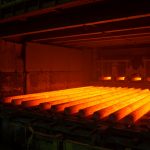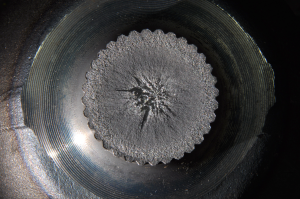The heat-treatment industry is essential to global manufacturing. The volatile, uncertain, complex, ambiguous (VUCA) landscape of the industry has led to many changes over time. In the 1980s, globalization was the focus, while in the 1990s, automation came to the fore. Moving into the 2000s and ongoing, energy transition was yet another factor for the industry to contend with. In the 2010s, the industry needed to address changes to global heat-treatment regulations and workforce reorganization. As we moved into the 2020s, a new era in manufacturing dawned with intelligent systems, incorporating the revolutionary concepts of the Industrial Internet of Things (IIoT) and Industry 4.0 smart manufacturing. (See Figure 1)
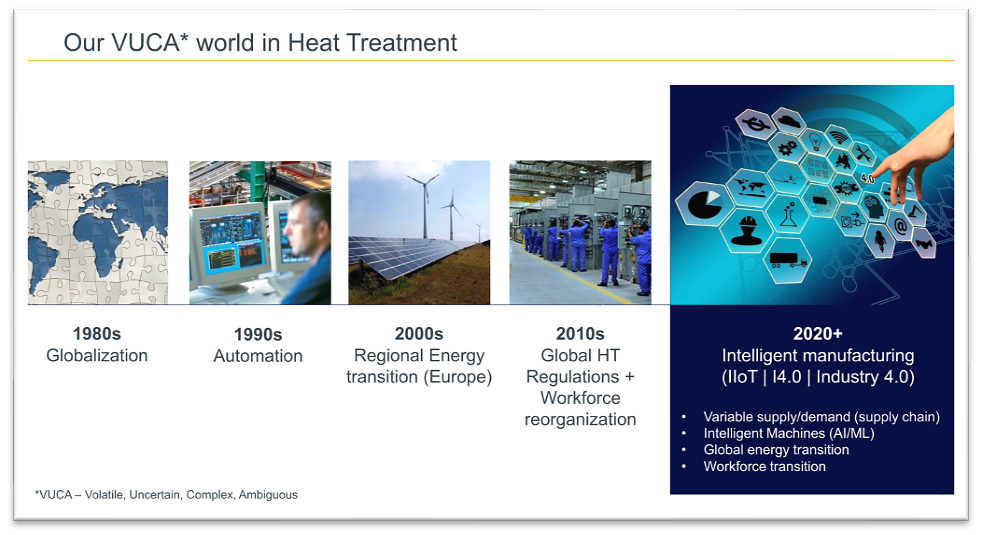
These changes have led to a point where digital transformation is no longer optional but essential. The advent of Industry 4.0, smart technologies, and interconnected systems is reshaping how heat-treatment plants operate. The push toward digitalization is driven by stringent standards such as AMS2750, CQI-9, and ISO 20431:2023, which mandate precise temperature control and detailed process documentation.
To stay competitive and meet these standards, the industry must adopt digital strategies that enhance operational efficiency and quality control.
Addressing workforce and equipment challenges
The heat-treatment industry also is grappling with a reduced and less experienced workforce, operating older and less efficient equipment. This can result in higher energy usage, decreased equipment reliability, and compromised process accuracy. Digital transformation offers solutions to these challenges by providing tools that can monitor and optimize operations. For example, fewer staff can manage larger operations effectively through automated systems and predictive maintenance, which can identify potential equipment failures before they occur. This approach not only reduces downtime but also extends the life of the equipment.
The untapped potential of data
Transitioning from paper-based records to digital platforms has exponentially increased the data available for improving operations. However, the industry faces a significant challenge: Much of this data remains underused due to difficulties in integration and analysis. The key is not just in data collection but in translating this data into actionable insights. Micro drifts in processes, often unnoticed over time, can now be detected through detailed data trends, enabling predictive maintenance and timely interventions. By harnessing this data, heat treaters can predict when to focus on specific actions, thereby enhancing decision-making and operational efficiency.
Modern systems provide data integration, advanced analysis, and data export, enabling the data collected to be more effectively used to give deeper insights into processes and allowing artificial intelligence (AI) and machine learning (ML) algorithms to be employed.
Customer goals: Health status, repair, and optimization
The need to drive efficiency and quality is linked to the status of equipment. This can be broken down into three core areas, all of which can be enhanced through digitalization (See Figure 2):
1 Health Status — Prioritize Attention: Monitoring the health status of equipment and processes in real time allows for prioritizing maintenance and attention where it’s most needed. This ensures critical issues are addressed promptly, maintaining high standards of operation.
2 Repair — Reduce Downtime: Predictive maintenance tools can significantly reduce downtime by identifying and addressing issues before they lead to equipment failure. This proactive approach minimizes disruptions and keeps operations running smoothly.
3 Optimize — Reduce Running Costs: Data-driven insights enable businesses to optimize their processes, reducing running costs through improved energy efficiency and resource allocation. By fine tuning operations based on real-time data, companies can achieve substantial cost savings.

Integrating advanced technologies
Advanced silicon-controlled rectifiers (SCRs), precise process controllers, and modern temperature sensors are essential elements to the heat-treatment process. Using SCRs that provide predictive load management and energy optimization, energy costs can be significantly reduced and peak loads managed efficiently without incurring tariff penalties. Sensors offer precise temperature measurements and feedback, connected to accurate PID controllers to ensure batch temperature profiles are consistently and precisely met. Additionally, advanced data management systems are crucial for recording process parameters, ensuring compliance with standards, and providing valuable insights for continuous improvement. (See Figure 3)
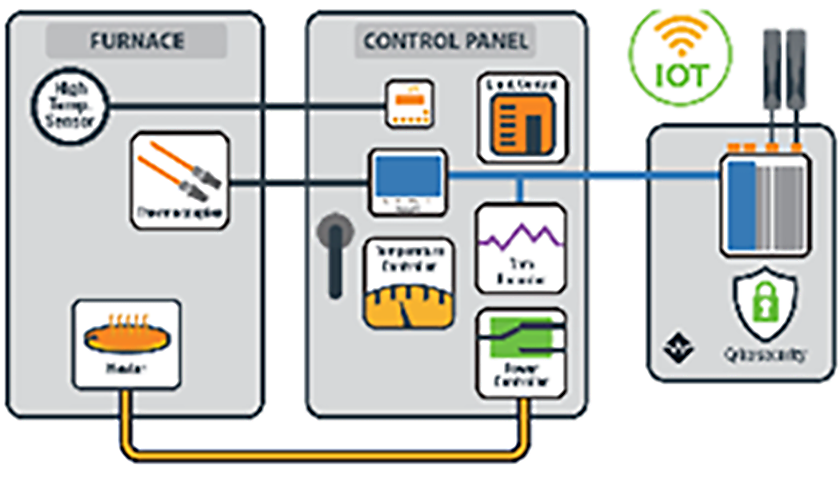
Overcoming integration challenges
Despite the benefits, the industry still struggles with integrating various components of the thermal loop. This lack of integration can lead to inconsistent quality, operational inefficiencies, and higher energy consumption. A holistic approach to data integration, where every segment of the thermal loop works seamlessly together, is becoming imperative for heat treaters to maximize equipment and energy utilization, ensure the highest quality, and remain competitive for the future. Such integration ensures data from sensors can be used in real time to adjust parameters, reduce energy consumption, and foresee maintenance needs, leading to enhanced operational efficiency and sustainability.
Leveraging AI and advanced analytics
Failure modes and effects analysis (FMEA) is useful for providing analysis of potential failures and corrective actions, but it requires a multi-discipline team, and there are reduced levels of experience across all departments: production, quality, and maintenance. Control systems use alarm levels to set high and low limits for process parameters, with alarms to warn if the process is moving out of specification. Unfortunately, this approach can often produce too many alarms, resulting in operators ignoring them, or can be too silent, leaving the process to drift out of control. AI and ML algorithms offer a solution.
AI and advanced analytics play a transformative role in this data-driven landscape. By analyzing patterns and trends within collected data, AI can predict equipment failures, schedule maintenance, and optimize energy consumption. This proactive approach not only reduces downtime but also enhances overall equipment effectiveness (OEE) by meticulously tracking availability, performance, and quality. ML models can process historical and real-time data to make informed predictions about system performance, enabling operators to make proactive adjustments. Through trending and understanding data, issues not normally detected, such as micro process drifts over time, sensor contamination, and the impact of speed of power switching on heater temperature fluctuation, can be discovered and predicted to enable remedial actions to be taken before they either affect the quality of a batch or the longevity of equipment. (See Figure 4)
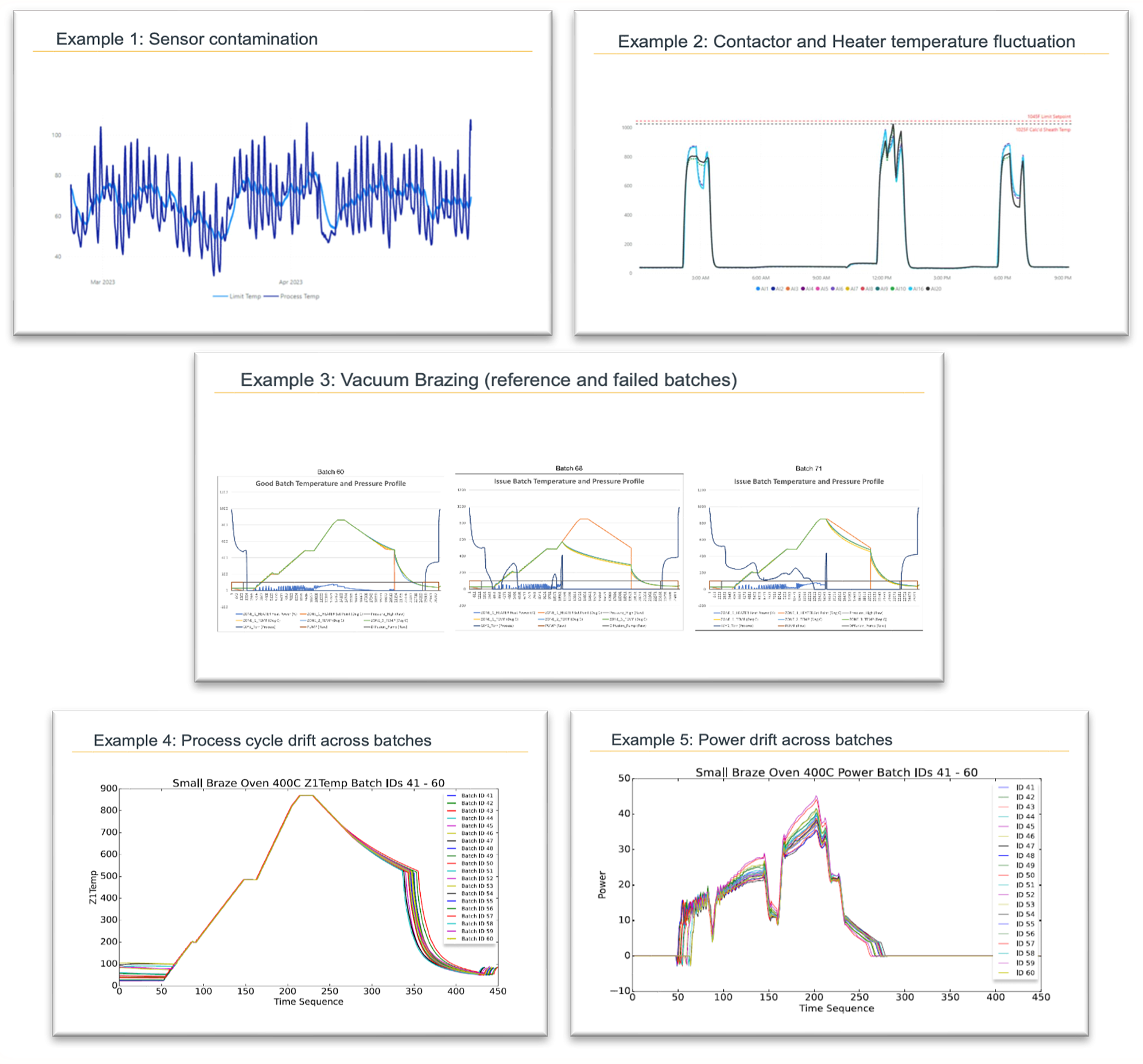
Conclusion: A data-driven future
The heat-treatment industry must embrace Industry 4.0 technologies to remain competitive in a rapidly advancing market. The integration of digital tools offers the ability to comply with stringent standards, optimize processes, and achieve sustainability goals. AI and ML are now essential tools for real-time process optimization and predictive maintenance, reducing downtime and increasing productivity. As the industry evolves, a merged design between heaters, sensors, PID controls, and power controllers within an Industry 4.0 framework will ensure rapid system response and tight control of process parameters. The future of the heat-treatment industry is not just bright; it is data-driven, promising increased efficiency, cost savings, and improved quality.














